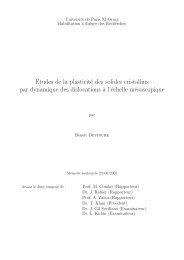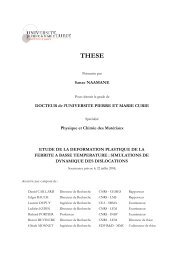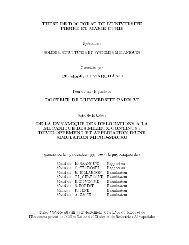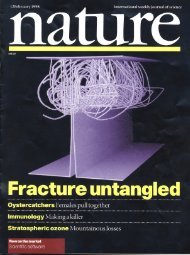Acta Materialia, 58(17) - Laboratoire d'Etude des Microstructures
Acta Materialia, 58(17) - Laboratoire d'Etude des Microstructures
Acta Materialia, 58(17) - Laboratoire d'Etude des Microstructures
Create successful ePaper yourself
Turn your PDF publications into a flip-book with our unique Google optimized e-Paper software.
S. Queyreau et al. / <strong>Acta</strong> <strong>Materialia</strong> <strong>58</strong> (2010) 5<strong>58</strong>6–5595 5593<br />
On one hand, the strengthening hierarchy is preserved<br />
<strong>des</strong>pite the presence of particles. With the collinear annihilation<br />
(Fig. 6a), primary dislocations are cut into many small<br />
segments—the signature of a large number of annihilations.<br />
Much collinear debris is formed in the shape of small loops.<br />
Primary dislocations are strongly bowed-out and this contrasts<br />
with the other interactions leading to junctions, where<br />
segments are less curved (Fig. 6b and d). Among junctions,<br />
symmetrical mixed junctions are relatively more numerous<br />
and longer than the other junctions, and primary dislocations<br />
are slightly more curved.<br />
On the other hand, specific observations can be made<br />
related to the presence of carbi<strong>des</strong>. First, in all the microstructures<br />
of Fig. 6, the primary dislocations are more curved<br />
than the equivalent ones obtained without carbi<strong>des</strong> [24] as<br />
the flow stress is larger, resulting from precipitate strengthening<br />
(see Fig. 7). Hence, forest junctions are 30% smaller<br />
than in simulations without precipitates. The mean length<br />
of junctions is 0:31q 1=2<br />
f<br />
for symmetrical mixed junctions,<br />
and 0:12q 1=2<br />
f<br />
for the two other types of junctions. Indeed,<br />
the existence of carbi<strong>des</strong> limits the junction zipping process.<br />
Moreover, dynamic effects are observed in the simulations.<br />
For instance, dislocations have to form very narrow angles<br />
around the carbi<strong>des</strong> to bypass them. The release of dislocation<br />
lines, once Orowan loops are formed, generally induces<br />
a <strong>des</strong>truction of neighboring junctions, hence initiating a<br />
plastic avalanche as <strong>des</strong>cribed in Ref. [44].<br />
Simulation results obtained in this section are now compared<br />
with the flow stress predictions made with different<br />
rules of mixtures and making use of the simulated flow<br />
Fig. 7. Stress–strain curves for latent hardening simulations with (continuous<br />
line) and without a carbide microstructure (dashed line). The two<br />
types of forest reaction considered are respectively the collinear annihilation<br />
(thick lines) and the asymmetrical mixed junction (thin line).<br />
stress obtained in the previous sections for Orowan<br />
strengthening and forest hardening individually. Existing<br />
solutions of rules of mixtures can be classified with the generic<br />
form s k tot ¼ sk 1 þ sk 2<br />
. From the seminal work of Brown<br />
and Ham [1] we know that the linear solution (k = 1) gives<br />
good results in the case of few strong obstacles dispersed in<br />
many weak obstacles. For instance, this solution is well<br />
adapted to the combination of dislocation interactions with<br />
solid-solution strengthening. It was also proposed to apply<br />
this solution, with slight modification, to the strengthening<br />
associated with the plastic zone formed around underformable<br />
particles in a plastically deformed metal matrix [45].<br />
Fig. 6. Simulated microstructure obtained under loading at c = 0.25% for the different simulations of latent hardening. The thin foils have a thickness of<br />
0.06 lm and belong to the primary slip plane. Junctions correspond to thick straight segments, and carbi<strong>des</strong> are in grey. The simulations involve<br />
respectively (a) collinear annihilations, (b) symmetrical mixed junctions, (c) asymmetrical mixed junctions and (d) edge junctions.









